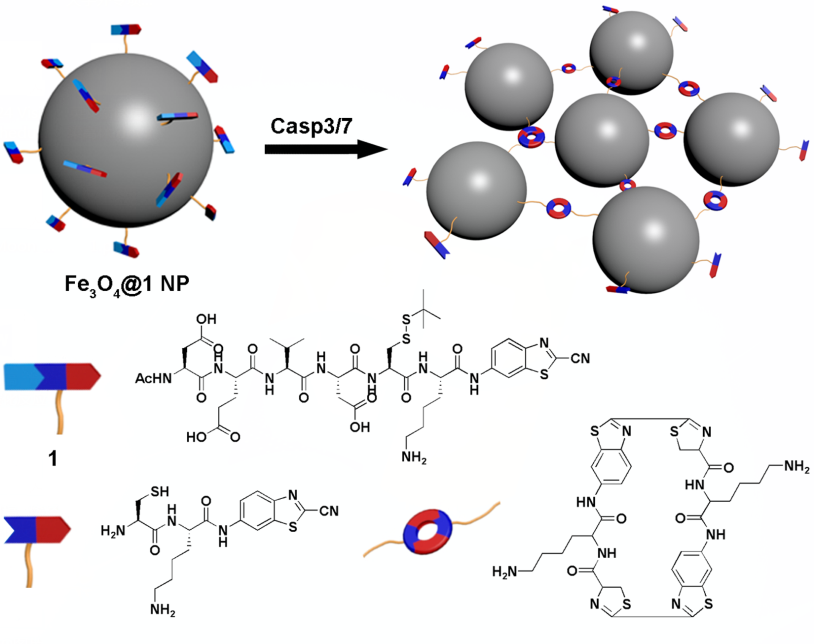
Prof. LIANG Gaolin’s group at the Department of Chemistry of the University of Science and Technology of China (USTC) of Chinese Academy of Sciences (CAS), by collaborating with Prof. ZHONG Kai’s group at the High Magnetic Field Laboratory of CAS, made big progress in developing a new imaging platform for evaluating chemotherapeutic response of tumor. They reported one novel magnetic resonance imaging (MRI) contrast agent which can “smartly” aggregate in apoptotic tumors, resulting in enhanced T2-weight MR signal. This work, titled “Casp3/7-Instructed Intracellular Aggregation of Fe3O4 Nanoparticles Enhances T2 MR Imaging of Tumor Apoptosis”, was published online in Nano Letters.
Caspases are important biomarkers for tumor apoptosis. The detection of Casp3/7 activity offers a favorable method for monitoring early apoptosis of tumor cells, thus can evaluate the effect of tumor chemotherapy, and provide a novel strategy for the follow-up treatment of tumor. MRI is one of the best noninvasive methods in medical imaging for assessing function of tissues or diagnosis of diseases. It has several advantages, such as excellent temporal and spatial resolution, long effective time window of imaging, and fine signal contrast. Large iron oxide nanoparticles and magnetic nanoparticle aggregates have shown dramatically higher transverse relaxation rates (R2) compared to ultrasmall superparamagnetic iron oxide (USPIO) nanoparticles (NPs). However, the former are more quickly cleared from the blood pool than the latter, which results in the decrease of the T2 MR signal of tissue.
In this study, the research group led by Prof. LIANG Gaolin designed a “smart” Fe3O4 nanoparticle (NP) complex (see Figure below). Employing a biocompatible click condensation reaction, this NP complex could be subjected to Casp3/7-instructed intracellular aggregation, resulting in enhanced T2 MR imaging signals in apoptotic cells or tumors. Cooperating with Prof. ZHONG Kai’s group, researchers acquired T2-weighted MR images of apoptotic tumor-bearing mice on a 9.4 T MR scanner (High Magnetic Field Laboratory, CAS). The results indicated that apoptotic tumors in Fe3O4@1 NPs-injected mice showed strong enhancement of T2 MR signal comparing with Fe3O4@1-Scr NPs-injected mice, and the NP complexes did not show toxicity to the mice. This platform for detecting Casp3/7 activity in vitro and in vivo was proven to be simple, accurate, and sensitive. It provides a novel strategy for efficient T2 MR imaging of chemotherapeutic response of tumor.
This work was supported by Collaborative Innovation Center of Suzhou Nano Science and Technology, the Major Program of Development Foundation of Hefei Center for Physical Science and Technology, Hefei Science Center CAS (2015HSC-UP012), the Fundamental Research Funds for the Central Universities (WK2060190054), and National Natural Science Foundation of China (Grants U1532144, 21375121,389 U1232212, and U1332142).

Figure: Flexible near-infrared solar cells based on plasmonic hot electron injection (Image by XIONG Yujie and Angewandte Chemie International Edition)

86-10-68597521 (day)
86-10-68597289 (night)

86-10-68511095 (day)
86-10-68512458 (night)

cas_en@cas.cn

52 Sanlihe Rd., Xicheng District,
Beijing, China (100864)

